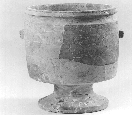Stone
Stone vessels, usually manufactured of malleable limestone,
were commonly found in the Jerusalem area in the late Second
Temple period. There are abundant examples in Qumran, in a
variety of shapes and sizes, which demonstrate expert
workmanship.
The reason for the use of some of these vessels can be found
in Jewish ritual law (halakhah). Stone, in contrast to pottery,
does not become ritually unclean (tamei). Jewish law maintains
that pottery vessels which have become ritually unclean must be
broken, never to be used again, whereas in similar circumstances
stone vessels retain their ritual purity and need not be
discarded (Mishnah. Kelim 10:11; Parah 3:2).
Widespread use of these stone vessels is particularly
evident because of their discovery in the excavations of the
Jewish Quarter in Jerusalem. Some of these vessels served the
same functions as ceramic vessels, and some had particular shapes
and functions. Although the raw material is common in Jerusalem,
the cost of production was, no doubt, far greater than that of
pottery. The flourishing manufacture of stone vessels came to an
end in the wake of the destruction of the Second Temple (70
C.E.).
- Measuring Cups

Limestone.
First century C.E.
KhQ 1036, KhQ 1604
Cup (A): height 7.5 cm (3 in.)
diameter 8 cm (3 1/8 in.)
Cup (B): height 12.8 cm (5 in.)
diameter 19.4 cm (7 1/2 in.)
Courtesy of the Israel Antiquities Authority (38,39)
Cylindrical cups of this type are frequently found in sites
of the Second Temple Period. It is believed that their capacities
correspond to the dry and liquid measures mentioned in the
Mishnah, a collection of rabbinic laws governing all aspects of
Jewish life.
The surfaces of these vessels were pared with a knife or
adze, and their surface was left un-smoothed. The vertical
handles rule out the possibility that they might have been
produced on a rotating lathe.
- Large Goblet

Limestone.
First century C.E.
Height 72 cm (28 1/4 in.)
Diameter 38.5 cm (15 1/8 in.)
Courtesy of the Israel Antiquities Authority (37)
This large goblet-shaped vessel was produced on a lathe,
probably in Jerusalem, and is extremely well crafted. It is
surprising that an ancient lathe was capable of supporting and
working such a large and heavy stone block. The vessel may shed
light on the shape of the "kallal," mentioned in the Talmudic
sources as a vessel for holding the purification ashes of the red
heifer (Mishnah Parah 3:3).



